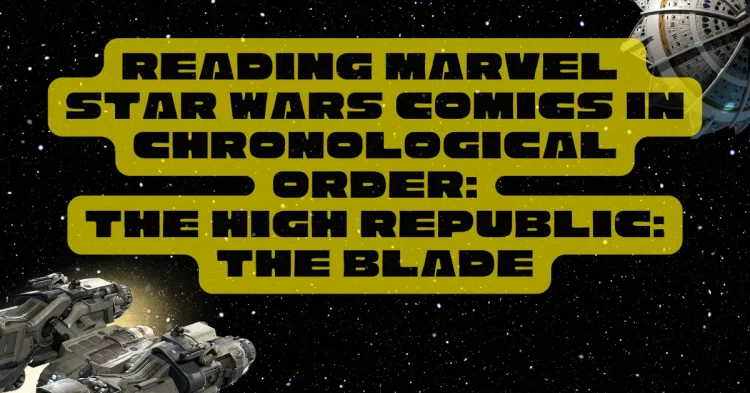The High Republic: The Blade is a standout entry in the Star Wars universe, diving deep into the emotional complexities of the Jedi Order. Written by Charles Soule, this comic takes readers to the High Republic era, a time when the Jedi were at their most powerful yet faced profound internal struggles.
The story follows Porter Engle, the legendary Blade of Bardotta, and his Jedi partner Barash Silvain as they navigate a mission to mediate a conflict on Tammuz-an, a planet on the brink of war. But more than a tale of peacekeeping, it’s a deeply personal exploration of attachment, faith, and morality, making it a compelling story.
With stunning visuals by pencillers Marco Castiello (issues 1-3) and Jethro Morales (issues 2-4), vibrant colors by Jim Charalampidis (issue 1) and Jim Campbell (issues 2-4), and lettering by Travis Lanham, this comic is as visually arresting as it is emotionally engaging.
Introduction to The High Republic: The Blade
Set during the golden age of the Jedi Order, The High Republic: The Blade takes readers to a galaxy full of expansion, optimism, and rising tensions. Penned by acclaimed Star Wars writer Charles Soule, this story centers on Tammuz-an, where Porter Engle and Barash Silvain are sent to mediate between two warring factions.

The comic’s breathtaking visuals owe much to the creative team. The dynamic artwork of Marco Castiello (issues 1-3) and Jethro Morales (issues 2-4) brings the galaxy to life, while the coloring by Jim Charalampidis (issue 1) and Jim Campbell (issues 2-4) highlights the emotional intensity of the story. The lettering by Travis Lanham ensures that every dialogue exchange and inner thought resonates with readers.
Porter Engle and Barash Silvain: A Bond That Breaks the Jedi Code
The heart of The High Republic: The Blade lies in the relationship between Porter Engle and Barash Silvain. While they are intriguing characters individually, it’s their bond as Jedi partners that makes this story unforgettable.
Porter Engle: The Blade of Bardotta
Porter Engle is a Jedi legend, renowned for his exceptional combat skills and diplomatic abilities. Porter’s physical presence and emotional depth leap off the page. However, beneath his confident exterior lies a man grappling with doubts about his purpose and the Jedi Code.

Barash Silvain: The Anchor of Wisdom
Barash, in contrast, serves as the moral anchor to Porter’s intensity. Her calm, reflective nature is brought to life through the expressive art and nuanced color work. Together, Porter and Barash form a bond that challenges the Jedi Code’s prohibition of attachment.
A Relationship That Defies Jedi Rules
The Jedi Code famously forbids attachment, yet Porter and Barash’s connection is undeniably deep. Their reliance on one another is both their greatest strength and their greatest vulnerability. This raises important questions about the practicality of the Jedi Code:
- Does detachment make Jedi better peacekeepers, or does it strip them of their humanity?
- Is attachment inherently dangerous, or can it be a source of strength?
Through the skilled storytelling of Charles Soule and the evocative art, these questions are explored with emotional depth and nuance.
These two Jedi are very much one. They discover this as younglings. Their attachment to each other is the centerpiece of this story.
Attachment and the Crisis of Faith
At its core, The High Republic: The Blade is a story of faith—faith in the Jedi Code, faith in one’s abilities, and faith in the idea of peace. As the mission on Tammuz-an spirals out of control, Porter and Barash are forced to confront profound questions about their roles as Jedi.
Key Conflicts
- The Jedi Code’s Limitations: The strict rules of the Jedi Code create emotional and moral dilemmas for Porter and Barash as they navigate their mission.
- Failure and Doubt: Mistakes are made that cause one of the Jedi to lose confidence in what makes them special. At the end of the book, this internal conflict isn’t resolved leaving the reader on a cliffhanger.
- Attachment vs. Detachment: Their bond becomes both a source of strength and a point of vulnerability, highlighting the emotional contradictions within the Jedi Order.
Key Themes in The High Republic: The Blade
1. The Flaws of the Jedi Code
The story challenges the idea that detachment is always necessary for Jedi. Porter and Barash’s bond demonstrates that attachment can both empower and endanger.
2. The Complexity of Faith
Faith is not static. This comic explores how faith can be shaken, questioned, and ultimately redefined.
3. Attachment as Strength and Weakness
Their relationship highlights the dual nature of attachment, adding emotional depth to the narrative.
The Even Better If
This is a minor criticism, as I understand the reasoning behind it, but the drawings from different artists don’t always align, for lack of a better phrase. This is especially true for Porter, where, in some drawings, he appears aged from the one before, even though no time has passed.
5. Why You Should Read The High Republic: The Blade
The High Republic: The Blade is one of the most thought-provoking entries in the Star Wars universe. Here’s why it deserves a place on your reading list:
- Character-Driven Narrative: Porter and Barash’s relationship is the beating heart of the story, offering a fresh perspective on the Jedi.
- Exploration of Complex Themes: From attachment to faith, the story delves into the emotional and philosophical struggles of being a Jedi.
- A New Era of Star Wars: The High Republic era provides a rich backdrop for storytelling, far removed from the Skywalker saga.
Whether you’re a long-time Star Wars fan or new to the High Republic series, this comic will leave you thinking long after you’ve finished reading.
This is the first in my summer reading adventure: Marvel Star Wars Comics in Chronological Order.
Have you read this comic? What are your thoughts? Share in the comments below!
About The Author
Discover more from NolaNerdCouple.com
Subscribe to get the latest posts sent to your email.

